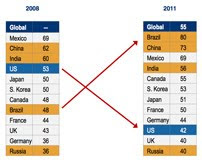
In 1972, prolific British dramatist David Campton wrote a seemingly simple one act play called Us And Them. If you've never heard of Campton, think of him as a playwright much like Arthur Miller, except leaning more toward the absurd.
His play, Us And Them, begins innocently enough with two groups of wanderers looking for a place to settle. And once they each find a plot of land stage left and stage right, both groups agree to mark a line between their two territories. Over time, the line becomes a fence and a fence becomes a wall and the wall grows in size until neither side knows what the other is doing.
Eventually, both sides begin to wonder what the other side might be doing. They wonder long enough that their thoughts turn to suspicion and suspicion to mistrust and mistrust to fear, with each side believing that the other is plotting against them. As fear takes hold, both sides unknowingly make preparations for ensuing conflict until eventually it explodes. In the end, two survivors, looking at the waste they have inflicted on one other, come to the conclusion that the wall was to blame.
The lesson about walls was never about walls.
 The irony about the play is that the lesson left by Campton was never about walls despite the interpretation of some high school theater teachers. The lack of transparency did nothing; only people and their obsession with the wall and fear of the unknown were to blame for mutual paranoid destruction.
The irony about the play is that the lesson left by Campton was never about walls despite the interpretation of some high school theater teachers. The lack of transparency did nothing; only people and their obsession with the wall and fear of the unknown were to blame for mutual paranoid destruction. If the recent publishing of the annual Edelman Trust Barometer is any indication of direction, the tone of U.S. politics with its incessant finger pointing at itself and other institutions has become a wall for the modern era. In fact, the U.S. was the only country in which trust in all institutions has declined.
As trust has declined overall, with growing frequency, the public has demanded more transparency. They demand it from businesses and business owners, politicians and government, executives and corporations, reporters and the media, themselves and each other. Tear down the walls, they exclaim with increased regularity.
It isn't only about institutions either. As Valeria Maltoni pointed out, trust in our own peers seems to have fallen in comparison to teachers, analysts, individual executives, and certain experts, where it has risen. While there are many theories as to why, it seems clear enough. Those capturing increased trust are perceived to have less power and cause for agenda or, in the case of individual executives, have already been forced to exhibit more transparency.
Forced transparency is a function of mistrust.
There is a reason the writers of the Constitution built in checks, balances, and transparency. Looking back in history, the founding fathers could find no evidence of a trustworthy government. Right. They mistrusted government or, more exactly, the agenda of men who might abuse its power.
"There is danger from all men. The only maxim of a free government ought to be to trust no man living with power to endanger the public liberty." — John Adams.
 Even James Madison warned that any nation which reposed too much on the pillow of political confidence would sooner or later see the end of its existence. Plainly speaking, we weren't supposed to trust our government or, more exactly, any men who might abuse its power. Even Patrick Henry pointed out that the Constitution is not an instrument for the government to restrain the people, it is an instrument for the people to restrain the government. And Adams himself later lamented some moments where he overreached as President.
Even James Madison warned that any nation which reposed too much on the pillow of political confidence would sooner or later see the end of its existence. Plainly speaking, we weren't supposed to trust our government or, more exactly, any men who might abuse its power. Even Patrick Henry pointed out that the Constitution is not an instrument for the government to restrain the people, it is an instrument for the people to restrain the government. And Adams himself later lamented some moments where he overreached as President. But what about each other? For the age, the founding fathers placed more trust in citizens to self-govern. Their only fear was that the public might fall prey to believing in promises of "necessity," aptly described as the plea for every infringement of human freedom. But other than that, they placed their trust in individuals and upheld the individual's right to be considered innocent (trustworthy) until evidence proved that they were not.
My primary point is that Americans are supposed to be suspicious not of government or hammers, but of those who are entrusted to manage its power. Our suspicions of everything else, with exception to those who have broken trust, are often made up. In other words, we obsess too much about the other side of the wall.
Authenticity is the measure by which we all benefit.
Although Maltoni cautioned me against using the term authenticity, favoring honesty, I still prefer it. Authenticity means being trustworthy, honest, and genuine. Contrary, transparency is a remedy of mistrust.
To help appreciate the difference, consider the micro view. A spouse who trusts their partner may never need ask any details if the partner has to meet someone for dinner. The trust is based on the authenticity their partner, specifically their resolve to never have an affair. It is only when the partner breaks that trust by having an affair that a trusting spouse might require transparency.
Please don't misunderstand me. Transparency can be considered an admirable quality, given that when we choose to share our thoughts, beliefs, lives, and stories, it can be considered a gift. But like all gifts, when it is demanded, it loses value.
Of course, someone offering up too much transparency (especially if they demand it of others), can also confound. The magician, for example, makes it a point to prove there is nothing up his or her sleeve before performing magic. The criminal might be the first to ask everyone to empty their pockets (especially if they passed the stolen item or hid it away). The agenda-driven professional may promise transparency but then never deliver after the contract is secure.
Most walls are only illusions and made by people.
In the play Us And Them, the wall was never to blame. Whether the wall was there or not wasn't even relevant. Most mistrust is created from within our imaginations.
 Just as we've seen in plenty of other stories and in history itself, if we lived without any walls (truly transparent, with cameras in our homes), the level of mistrust would increase exponentially as someone would be charged with deciphering our every motivation. Or, equally correct, one could say there is no trust in a world where people aren't given the freedom to exhibit it.
Just as we've seen in plenty of other stories and in history itself, if we lived without any walls (truly transparent, with cameras in our homes), the level of mistrust would increase exponentially as someone would be charged with deciphering our every motivation. Or, equally correct, one could say there is no trust in a world where people aren't given the freedom to exhibit it. It seems the solution is not attempting to bind individuals to greater degrees of public scrutiny as some people propose by policy or regulation or declaration, but rather binding people to cooperate in environments built on mutual trust, based on nothing more than "what is" as opposed to "what might be." That is what gave us the strength throughout history to accomplish micro tasks like rock climbing or macro tasks like landing on the moon.
When you think about it, this direction even holds in the earlier micro example that explores jealous spouses. The are four common breakdowns of trust in marriages, with one being functional and three being dysfunctional. Maybe more.
Functional mistrust is an outcome of evidence, which is the only one that warrants transparency as a foothold for restoration. Dysfunctional mistrust, on the other hand, is caused by our own insecurities, misinterpretations, and/or misapplying past experiences with people who don't deserve it. In those instances, we might take a harder look at ourselves more than others.
Three related articles about trust and power.
• Distrust in leaders: dimensions, patterns, and emotional intensity.
• Poverty is more likely cause of mistrust than race, says study.
• Messaging trust and the decline of peers.































